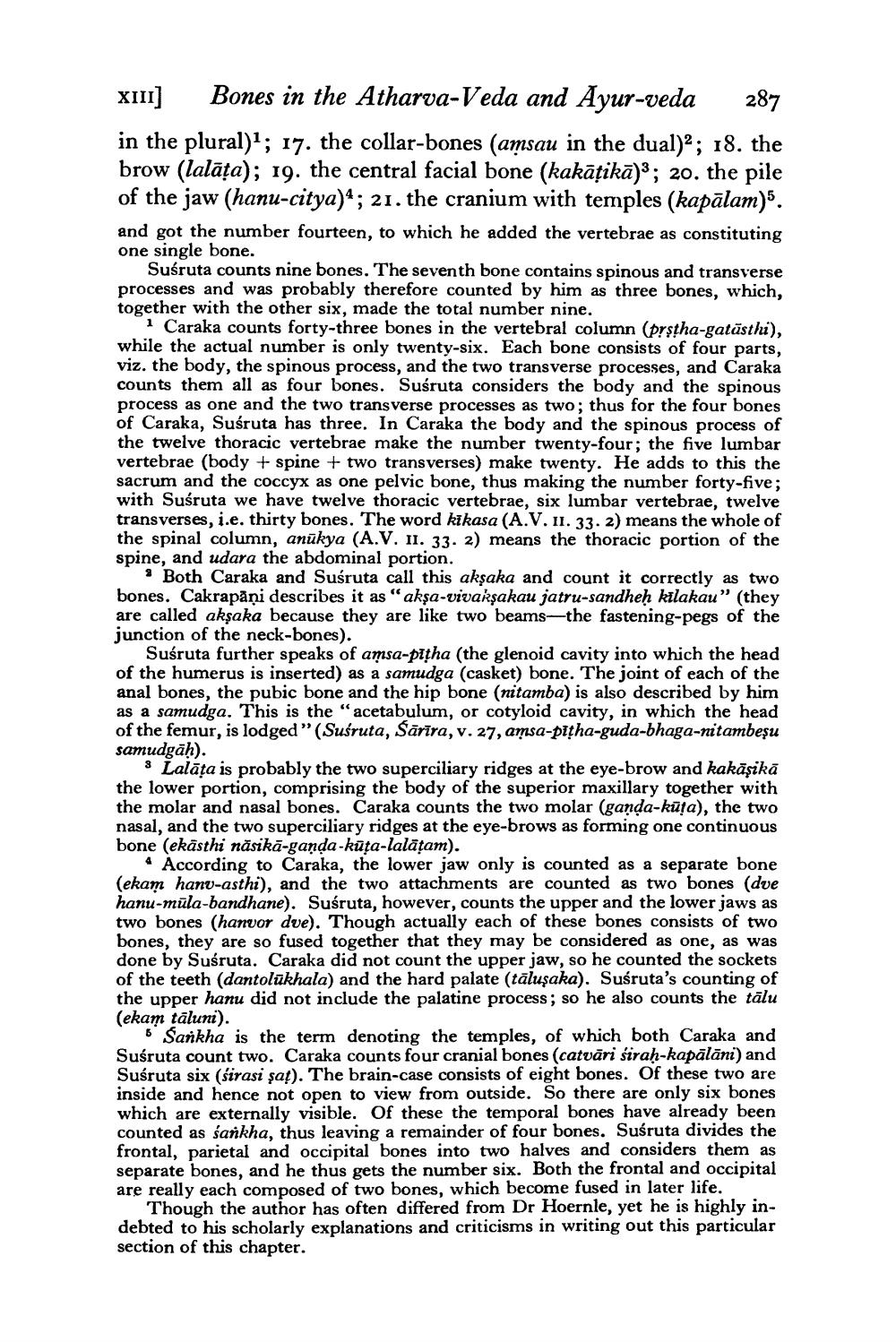________________
X111] Bones in the Atharva-Veda and Ayur-veda 287 in the plural)?; 17. the collar-bones (amsau in the dual)2; 18. the brow (lalāța); 19. the central facial bone (kakāţikā)); 20. the pile of the jaw (hanu-citya)*; 21. the cranium with temples (kapālam)5. and got the number fourteen, to which he added the vertebrae as constituting one single bone.
Susruta counts nine bones. The seventh bone contains spinous and transverse processes and was probably therefore counted by him as three bones, which, together with the other six, made the total number nine.
1 Caraka counts forty-three bones in the vertebral column (prstha-gatāsthi), while the actual number is only twenty-six. Each bone consists of four parts, viz. the body, the spinous process, and the two transverse processes, and Caraka counts them all as four bones. Susruta considers the body and the spinous process as one and the two transverse processes as two; thus for the four bones of Caraka, Susruta has three. In Caraka the body and the spinous process of the twelve thoracic vertebrae make the number twenty-four; the five lumbar vertebrae (body + spine + two transverses) make twenty. He adds to this the sacrum and the coccyx as one pelvic bone, thus making the number forty-five; with Susruta we have twelve thoracic vertebrae, six lumbar vertebrae, twelve transverses, i.e. thirty bones. The word kikasa (A.V. 11. 33. 2) means the whole of the spinal column, anūkya (A.V. II. 33. 2) means the thoracic portion of the spine, and udara the abdominal portion.
Both Caraka and Susruta call this akşaka and count it correctly as two bones. Cakrapāņi describes it as "akşa-vivakşakau jatru-sandheḥ kilakau” (they are called akşaka because they are like two beams--the fastening-pegs of the junction of the neck-bones).
Susruta further speaks of amsa-pitha (the glenoid cavity into which the head of the humerus is inserted) as a samudga (casket) bone. The joint of each of the anal bones, the pubic bone and the hip bone (nitamba) is also described by him as a samudga. This is the "acetabulum, or cotyloid cavity, in which the head of the femur, is lodged" (Susruta, Sārīra, v. 27, amsa-pitha-guda-bhaga-nitambeşu samudgāh).
3 Lalāta is probably the two superciliary ridges at the eye-brow and kakāşikā the lower portion, comprising the body of the superior maxillary together with the molar and nasal bones. Caraka counts the two molar (ganda-kūta), the two nasal, and the two superciliary ridges at the eye-brows as forming one continuous bone (ekāsthi năsika-ganda-küta-lalātam).
4 According to Caraka, the lower jaw only is counted as a separate bone (ekam hanu-asthi), and the two attachments are counted as two bones (dve hanu-müla-bandhane). Susruta, however, counts the upper and the lower jaws as two bones (hanvor dve). Though actually each of these bones consists of two bones, they are so fused together that they may be considered as one, as was done by Suśruta. Caraka did not count the upper jaw, so he counted the sockets of the teeth (dantolūkhala) and the hard palate (tāluşaka). Susruta's counting of the upper hanu did not include the palatine process; so he also counts the tālu (ekam tāluni).
Sankha is the term denoting the temples, of which both Caraka and Susruta count two. Caraka counts four cranial bones (catvāri sirah-kapālāni) and Susruta six (sirasi şat). The brain-case consists of eight bones. Of these two are inside and hence not open to view from outside. So there are only six bones which are externally visible. Of these the temporal bones have already been counted as sankha, thus leaving a remainder of four bones. Susruta divides the frontal, parietal and occipital bones into two halves and considers them as separate bones, and he thus gets the number six. Both the frontal and occipital are really each composed of two bones, which become fused in later life.
Though the author has often differed from Dr Hoernle, yet he is highly indebted to his scholarly explanations and criticisms in writing out this particular section of this chapter.




